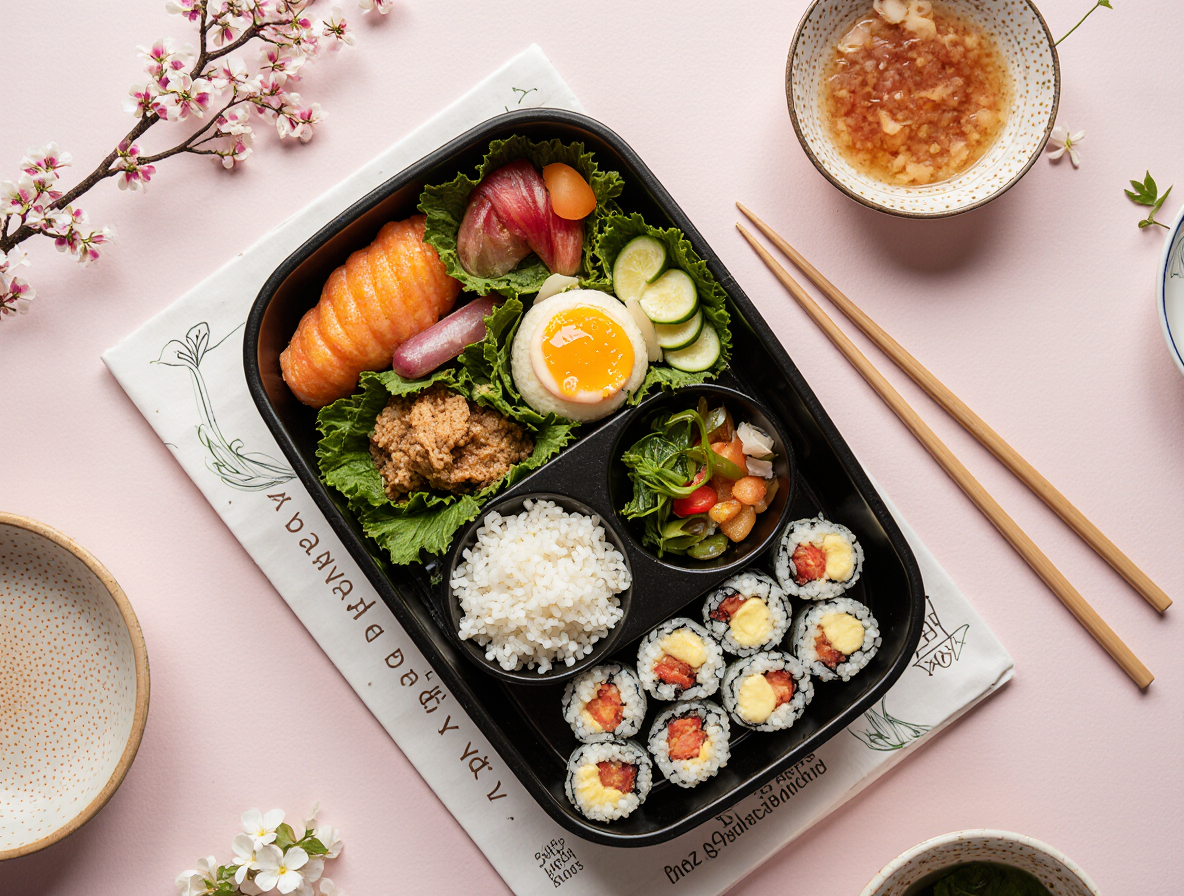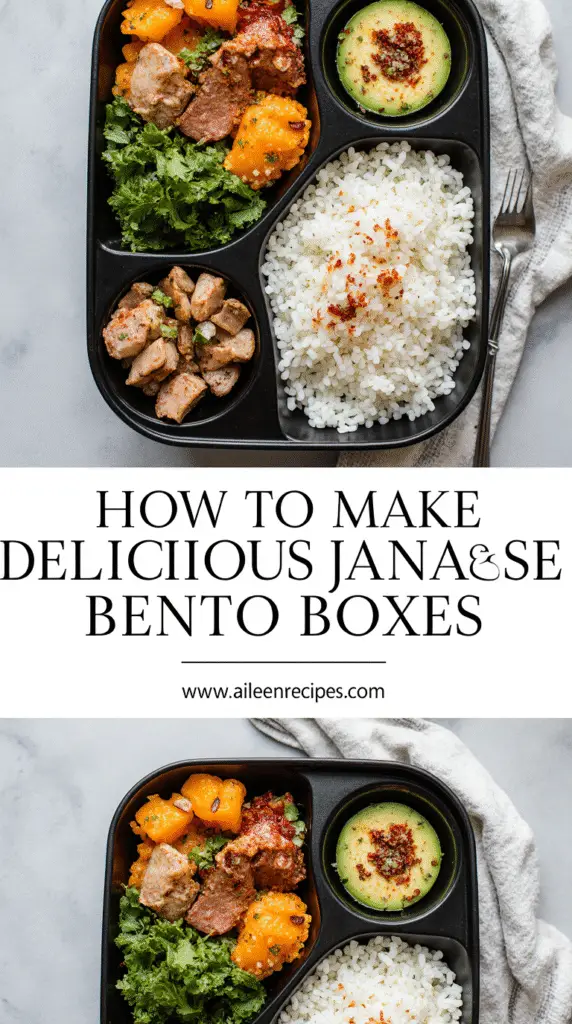How to Make Beautiful Bento Box Recipes: A Step-by-Step Guide for Beginners
Did you know that Japanese bentos are actually meant to be eaten at room temperature?
Surprisingly, this is just one of many fascinating aspects of bento box recipes that make them so unique. When we open a bento box, it’s almost like discovering a treasure box of delightful foods carefully arranged inside. We’ve found that Japanese bento boxes offer more than just a pretty meal—they’re reusable containers that help reduce plastic waste and disposable packaging.
Additionally, bento box lunch recipes typically feature rice as the main component, accompanied by various small portions of colorful sides and protein options. The food in Japanese bento box recipes tends to be more heavily seasoned so it tastes better when consumed at room temperature. If you’re wondering how to make a bento box that’s both beautiful and delicious, you’re in the right place. Easy bento box recipes are perfect for meal prep, allowing us to enjoy healthy, homemade lunches on the go.
In this step-by-step guide, we’ll walk you through everything you need to know about creating stunning bento boxes—from selecting the right container to arranging your food in a visually appealing way. Whether you’re packing lunch for yourself or your loved ones, these techniques will help you create a meal that’s as pleasing to the eye as it is to the palate.
Understanding the Basics of Bento
Understanding the Basics of Bento
The Japanese tradition of bento spans back to the Kamakura Period (1185-1333), beginning as a simple way for travelers and warriors to carry their meals. Throughout centuries, this practice has evolved into an art form that beautifully balances nutrition and esthetics.
What is a Japanese bento box?
A bento (弁当, bentō) is a single-portion, packed meal that’s traditionally assembled in a box with compartments. Primarily featuring rice or noodles as the foundation, these boxes typically include:
- Protein sources like fish, meat, eggs, or tofu
- An assortment of pickled or cooked vegetables
- Small portions of seasonal fruits
- Various side dishes for flavor variety
These components generally follow a 4:3:2:1 ratio of carbs, protein, vegetables, and pickled items or fruits respectively. The containers themselves range from mass-produced plastic varieties to handcrafted lacquerware or traditional cedar wood boxes, which offer natural antimicrobial properties.
Why bento is eaten at room temperature
Fundamentally, Japanese bentos are designed to be consumed at room temperature. This isn’t merely tradition—it’s practical. Food in bento boxes is often more heavily seasoned to ensure it tastes delicious without reheating. Additionally, many Japanese households prepare bentos in the morning for consumption several hours later at work or school.
To maintain food safety, bentos follow specific preparation guidelines. Deep-fried items are thoroughly reheated before packing and allowed to cool completely. Moreover, dividers called “baran” (often green plastic “sushi grass”) are used to separate strong-flavored items and slow bacterial growth.
Health and lifestyle benefits of bento
The compartmentalized design of bento boxes naturally promotes portion control and balanced nutrition. Each section limits how much food can be packed, encouraging moderation without calorie counting.
Furthermore, the variety of foods in a traditional bento exposes children to different food types, expanding their palates and making them more receptive to healthier options. The visual appeal also plays a crucial role—research shows that well-presented food increases consumption, particularly when including a rainbow of colors.
Beyond health advantages, bento boxes offer practical benefits. They’re economical compared to buying meals daily, eco-friendly due to their reusable nature, and perfect for busy individuals seeking convenient yet nutritious options.
Essential Tools and Accessories
Essential Tools and Accessories
Selecting appropriate equipment is a crucial first step in creating beautiful Japanese bento box recipes. The right tools not only enhance convenience but also significantly impact food presentation and safety.
Choosing the right bento box
The material of your bento box affects weight, durability, and cleaning—making it essential to select one that matches your lifestyle. Plastic boxes are lightweight and typically microwave and dishwasher-safe, while stainless steel options offer durability and odor-resistance. For traditionalists, wooden boxes provide timeless charm despite requiring more maintenance.
Size matters significantly when selecting your container. For children, aim for volumes between 300-600ml, adults need 600-1000ml boxes, whereas meal prep sets should exceed 1000ml. Many people find that having at least two different types of bento boxes works best—one compact Japanese-style box for densely packed meals, plus a larger container for salads or sandwiches.
Useful accessories: dividers, picks, and sauce containers
Beyond the box itself, certain accessories enhance both functionality and visual appeal. Silicone baking cups serve as excellent dividers, helping separate different foods while adding color. Small condiment containers securely hold sauces without leakage.
Food picks shaped like animals or characters make eating more enjoyable, especially for children, by transforming ordinary foods into delightful bites. For those interested in traditional Japanese presentations, onigiri (rice ball) molds and seaweed cutters create authentic touches.
Thermal vs non-thermal containers
Standard bento boxes are designed for room-temperature foods. Nonetheless, if you prefer hot meals, thermal options exist. The first type consists of stainless steel insulated containers with plastic inner containers. Mr. Bento exemplifies this design—featuring containers for rice, soup, and side dishes, though it tends to be heavy and bulky.
Alternatively, thermos-style lunch jars offer simplicity for carrying single hot items like soups or stews. Remember that food continues cooking inside thermal containers, consequently affecting texture and flavor—making them ideal primarily for slow-cooked dishes.
Planning and Prepping Your Bento
Planning and Prepping Your Bento
Successful bento box preparation begins with thoughtful planning. Rather than scrambling each morning, developing a weekly menu strategy saves time and ensures nutritionally balanced meals.
How to plan a balanced bento menu
Traditional Japanese bento boxes typically incorporate five food types: carbohydrates (rice/noodles), protein (meat/fish/eggs), vegetables, colorful fillers (edamame/cherry tomatoes), and fruits. This variety naturally creates a rainbow of colors which makes the meal visually appealing and nutritionally complete. First, visualize how your bento should look, even sketching the compartments if you’re new to bento making. Subsequently, check what ingredients you already have to minimize waste and grocery expenses.
Meal prep tips for busy mornings
Dedicate 2-3 hours on weekends for efficient meal preparation. Cook multiple dishes simultaneously, focusing on items with similar cooking times. Prepare and wash everything ahead, storing each component in separate airtight containers in the refrigerator. Throughout the week, simply reheat, cool, and pack your bento in minutes. In addition, cooking double portions during dinner preparations creates ready-to-use bento components.
Freezer-friendly and make-ahead ideas
Numerous bento components freeze exceptionally well. Store cooked rice with steam sealed in for up to one month. Likewise, store cooked dishes in portion-sized containers for up to three weeks. For deep-fried items, cool completely before freezing, then reheat at 375°F without thawing for optimal crispiness. Blanched vegetables remain usable for 2-3 weeks when thoroughly dried before freezing.
Using leftovers creatively
Leftover dinner components often make perfect bento fillings. Transform remaining stir-fry, hambagu (Japanese hamburger), or curry into colorful compartments. Even soups can become bento components—simply drain the liquid and use the solid ingredients.
How to Pack a Beautiful Bento Box
How to Pack a Beautiful Bento Box
Creating an eye-catching bento begins with proper packing techniques that transform simple ingredients into visual masterpieces.
Step-by-step packing process
First, pack your bento box when food has completely cooled to room temperature to prevent condensation and bacterial growth. Start with carbohydrates (typically rice) in one corner, occupying approximately half the box. Next, place vegetables from the opposite side, followed by your protein in the center. Finally, fill any remaining gaps with colorful garnishes or small side dishes. Always pack tightly to prevent shifting during transport.
Layering carbs, proteins, and sides
Traditional Japanese bento boxes follow specific proportions: 4:2:1 ratio of carbohydrates, proteins, and vegetables. For a nutritionally balanced meal, consider increasing vegetables to create a 4:3:2:1 ratio including fruits or pickled items. Use silicone cups to separate different components, helping maintain distinct flavors and textures. Remove excess liquid from foods to prevent sogginess and cross-contamination.
Color balance and visual appeal
Aim to incorporate at least four different colors in your bento for visual interest. Pair complementary colors (green with red, orange with blue) to create striking contrasts. Consider cookie cutters to shape ingredients into hearts, stars, or other playful designs. Place foods with contrasting colors adjacent to each other for maximum visual impact.
Food safety and cooling tips
In hot weather, avoid moist proteins, soft-boiled eggs, soupy dishes, raw tofu, and dairy products. Instead, opt for thoroughly cooked proteins, deep-fried items, and antibacterial ingredients like vinegar, wasabi, and pickled plum. Always include ice packs, particularly during summer months, placing them directly on top of your bento for optimal cooling. For long commutes, use insulated bags to maintain safe temperatures below 46°F.
Conclusion
Bento boxes offer much more than just a pretty meal. Throughout this guide, we’ve explored the fascinating world of these Japanese packed lunches, from their rich historical roots to practical packing techniques. Most importantly, these artfully arranged meals provide a perfect balance of nutrition, portion control, and visual appeal that can transform ordinary lunches into extraordinary experiences.
Creating beautiful bentos doesn’t require professional culinary skills. After all, anyone can master this art with some practice and the right tools. Starting with a suitable container, adding colorful foods in the traditional ratio, and arranging them thoughtfully will result in visually stunning meals your family or colleagues will admire.
The time-saving benefits of bento preparation cannot be overstated. Weekend meal prep significantly reduces morning stress while ensuring we enjoy nutritious homemade meals throughout the week. Similarly, repurposing leftovers into creative bento components minimizes food waste and maximizes our cooking efforts.
Beyond esthetics, bento boxes help us develop healthier eating habits. The compartmentalized design naturally encourages portion control and dietary variety without strict calorie counting. Consequently, we end up consuming a wider range of nutrients while enjoying a visually stimulating meal experience.
Whether you’re packing lunch for yourself, your children, or your partner, bento boxes provide a unique opportunity to show care through food. The beautiful presentation says “I care” in a way few other lunches can match. Therefore, we encourage you to try your hand at these colorful, balanced meals – your taste buds and wellbeing will thank you for it.
Remember, bento making is both an art and practice that improves with time. Soon, you’ll find yourself naturally creating Instagram-worthy lunches that are as nourishing as they are beautiful. Start simply, experiment often, and watch as bento boxes transform your midday meals into moments of joy.
FAQs
Q1. What is a bento box and why is it popular? A bento box is a single-portion packed meal typically containing rice, protein, vegetables, and side dishes. It’s popular due to its balanced nutrition, portion control, visual appeal, and convenience for on-the-go meals.
Q2. How do I choose the right bento box? Consider the material (plastic, stainless steel, or wood), size (300-600ml for children, 600-1000ml for adults), and whether you need thermal properties. Having two types – a compact Japanese-style box and a larger container for salads – can be beneficial.
Q3. What’s the ideal ratio for packing a bento box? The traditional ratio is 4:3:2:1 for carbs, protein, vegetables, and pickled items or fruits, respectively. This ensures a balanced meal with variety in both nutrition and flavors.
Q4. How can I make my bento box visually appealing? Incorporate at least four different colors, use silicone cups as dividers, arrange contrasting colors next to each other, and consider using cookie cutters for fun shapes. Pack tightly to prevent shifting during transport.
Q5. What are some time-saving tips for bento preparation? Dedicate 2-3 hours on weekends for meal prep, cook multiple dishes simultaneously, and store components separately. Freeze suitable items like cooked rice and blanched vegetables. Repurpose dinner leftovers creatively for quick and easy bento fillings.


